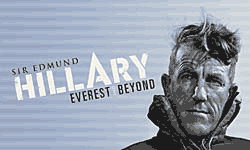 A t building number 1145, 17th Street North West in Washington DC, in the Explorers Hall, the folks at National Geographic have created an impressive exhibit entitled 'Sir Edmund Hillary: Everest Beyond', replete with an entirely recreated Sherpa school classroom.
A t building number 1145, 17th Street North West in Washington DC, in the Explorers Hall, the folks at National Geographic have created an impressive exhibit entitled 'Sir Edmund Hillary: Everest Beyond', replete with an entirely recreated Sherpa school classroom. The exhibition explores all aspects of Hillary's life, from his early years as a beekeeper and novice climber, to his celebrated Everest climb 50 years ago alongside Tenzing Norgay, to his humanitarian work for the people of the Himalaya. Told through panoramic landscapes, original film footage of the 1953 expedition, replica Sherpa buildings and objects from the Everest ascent, the exhibit also charts Hillary's other journeys. They include his South Pole tractor trek from 1956 to 1958 and his jet boat pilgrimage up the Ganges River following the death of his wife and daughter in 1975.
While the exhibition is strong in many aspects, the focus is excessively Hillary-centric. This is particularly ironic and unbecoming given that Hillary (invariably referred to as Sir Edmund Hillary in the exhibition) has retained his charming humility and unpretentiousness to this day. Overt Hillary fetishes on show include the ice axe he used on Everest, his Kodak Retina 35mm camera that recorded the legendary summit photographs, the clothing he wore on the summit, the nylon rope, oxygen frame, pack and mask he used during the climb, one of the three tractors he drove to the South Pole, various religious and domestic Sherpa artefacts, and a selection of Hillary's many awards and decorations, from the Order of the Garter to the Kathmandu Taxi Drivers Association Award. We are thankfully spared his toenail clippings and used underwear.
The exhibition organisers should be given credit for their sensitive handling of the often acrimonious debate about who got to the top first, the nationality of Tenzing Norgay (Nepali or Indian) and the sore fact that he was never made Sir Tenzing. As for the wall panels devoted to the Yeti, they are unsensationalist and straightforward, combining excellent visuals with solid commentary-the kind of reporting we have come to expect from National Geographic.
 Aiming for embedded interactivity, the curators of the exhibition have decided to let visitors walk across a ladder over an image of a crevasse and try on backpacks of various weights to simulate what Hillary and the team carried up Everest as a reminder of how heavy the loads felt at different altitudes. Watching an entire family of severely overweight visitors strap the packs on and waddle around proclaiming success induced greater queasiness than altitude itself.
Aiming for embedded interactivity, the curators of the exhibition have decided to let visitors walk across a ladder over an image of a crevasse and try on backpacks of various weights to simulate what Hillary and the team carried up Everest as a reminder of how heavy the loads felt at different altitudes. Watching an entire family of severely overweight visitors strap the packs on and waddle around proclaiming success induced greater queasiness than altitude itself. The exhibition runs until 1 September, but for the more sedentary readers, there is also an excellent website, www.nationalgeographic.com/everest, which is full of sound and music signifying the Himalaya.
Imaging Everest, a photographic exhibition is currently on display at the British Council, Lainchaur. The 84 original photographs from the Royal Geographical Society's archives in London cover the first attempt on Everest till 1953 when Tenzing Norgay and Edmund Hillary made the summit. The exhibition will be on till 31 July.


